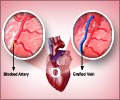High risk coronary artery plaque and a common liver disease have been found to be closely associated, in a research that used coronary computed tomography angiography.

"As it is known that atherosclerosis is linked to inflammation, our next step was to look for an association of high-risk plaques with other systemic inflammatory conditions such as NAFLD," said the study's lead author, Stefan B. Puchner, M.D., from Massachusetts General Hospital and Harvard Medical School in Boston and the Medical University of Vienna, Austria. "Interestingly, both pathologies can be detected in a single CT examination."
The researchers drew patients from a large trial focusing on the use of CCTA in people who had come to the emergency department with acute chest pain. The patients underwent both non-enhanced CT to assess coronary calcium, a marker of atherosclerosis, and contrast-enhanced CCTA. Readers assessed the CCTA images for signs of high-risk plaque.
Overall, 182 of the 445 patients in the study, or 40.9 percent, had CT evidence of NAFLD. High-risk plaque was seen in 59.3 percent of patients with NAFLD, compared to only 19 percent of those without NAFLD. The association between NAFLD and high-risk plaque persisted after adjusting for the extent and severity of coronary atherosclerosis and traditional risk factors.
The results suggest that high-risk plaque and NAFLD are both part of the same systemic disease process, the metabolic syndrome.
"The clinical implications could include a wider assessment of NAFLD using the non-contrast cardiac CT scans that are commonly performed prior to the CTA," he said. "Further, the additional assessment of NAFLD with CT could improve the risk stratification of patients with suspected coronary artery disease, as our results show that the presence of NAFLD is associated with high-risk coronary plaque independent of traditional risk factors and severity of coronary artery disease."
"The aim will be to further investigate and understand, with the help of CCTA, the interplay between advanced atherosclerosis and NAFLD as part of a complex systemic inflammatory condition," Dr. Puchner said.
 MEDINDIA
MEDINDIA




 Email
Email










